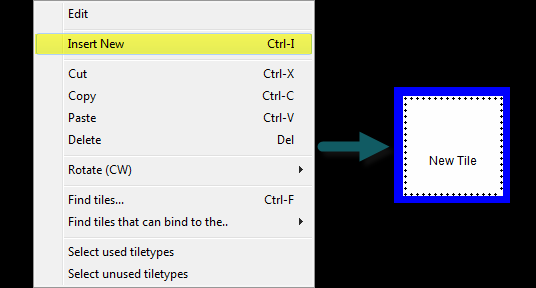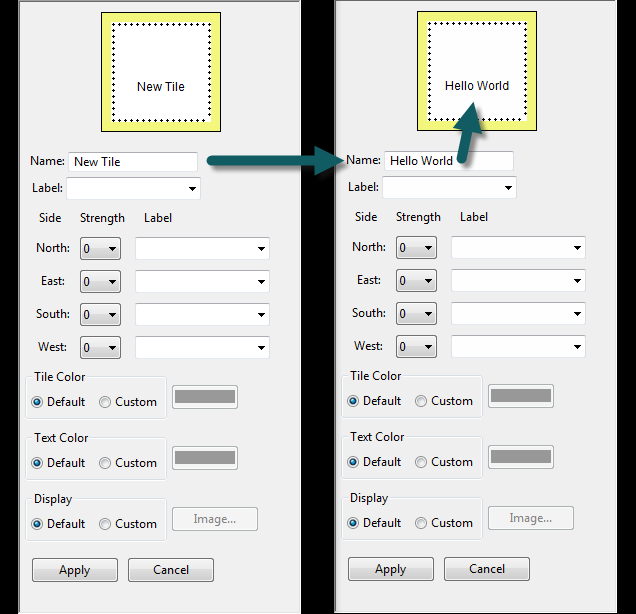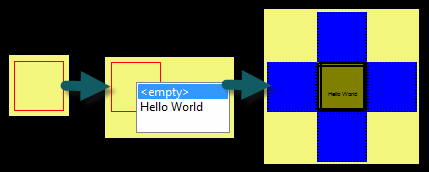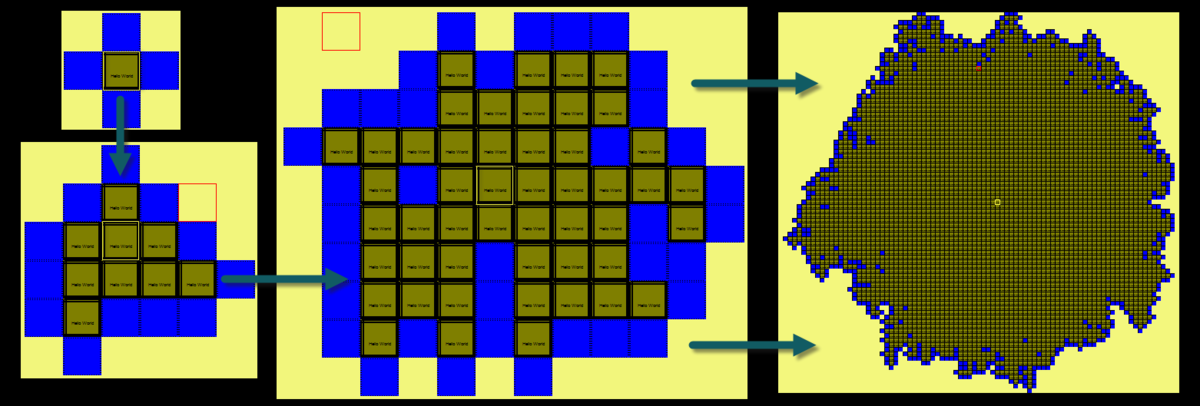Difference between revisions of "Your first tile assembly"
Jhendricks (talk | contribs) m (Fixed Typo→The Undirected Uni-tiled Blob) |
|||
| Line 13: | Line 13: | ||
[[File:New_tile.png|thumb||center|upright=3.0|alt=Tile Type Def|Tile Type Definition Window]] | [[File:New_tile.png|thumb||center|upright=3.0|alt=Tile Type Def|Tile Type Definition Window]] | ||
| − | After giving your tile a name it is now time to give it glue values for each of its edges. Tiles in TAS have four sides, each of which is the same length; a tile is a square. Each side, or edge, of the tile corresponds to a cardinal direction. Above the name of the tile is the North edge, to the right of the name is the East edge, etc. Along the edges of a tile you have the option of applying glues. Glues can | + | After giving your tile a name it is now time to give it glue values for each of its edges. Tiles in TAS have four sides, each of which is the same length; a tile is a square. Each side, or edge, of the tile corresponds to a cardinal direction. Above the name of the tile is the North edge, to the right of the name is the East edge, etc. Along the edges of a tile you have the option of applying glues. Glues can have an arbitrary non-negative integer value (0, 1, 2,...) as a strength in TAS. Go ahead and apply strength 2 glues to all of the edges of your tile. |
[[File:New_tile_glues.png|thumb||center|upright=4.0|alt=Adding Glues]] | [[File:New_tile_glues.png|thumb||center|upright=4.0|alt=Adding Glues]] | ||
Revision as of 15:46, 12 August 2013
Contents
Introduction
This tutorial will introduce you to some of the basic concepts of tile assembly as well as some of the basic features of TAS. We will start with a simple assembly that consists of a single tile that spreads in a blob-like fashion. At the end of the tutorial we will present you with a challenge concerning caging the Blob.
The Undirected Uni-tiled Blob
Before we can witness our Blob assembling in the Simulation Window we must first create a tile in the Tileset Editor window. Luckily because our Blob is a simpleton he consists only of a single tile. To create a tile right click in the Tiletype editor and select Insert New.
A tile will appear in the editor with a blue square around it. Whenever this blue square is around a tile in the Tiletype editor it means that this tile is currently selected and that you may edit its features in the Tile Type Definition window.
Now it is time to give your tile a name. I will call mine Hello World, but you may name your tile as you please. Strictly speaking, a tile name will not affect how your tiles will assemble. Tile names are simply a way for you to recognize and organize your tiles and tile sets. Below you can see a picture of the Tile Type Definition window. Any changes you make in this window will automatically be reflected in the tile you have selected. To make the changes permanent you must select Apply. Go ahead and select Apply after you name your tile.
After giving your tile a name it is now time to give it glue values for each of its edges. Tiles in TAS have four sides, each of which is the same length; a tile is a square. Each side, or edge, of the tile corresponds to a cardinal direction. Above the name of the tile is the North edge, to the right of the name is the East edge, etc. Along the edges of a tile you have the option of applying glues. Glues can have an arbitrary non-negative integer value (0, 1, 2,...) as a strength in TAS. Go ahead and apply strength 2 glues to all of the edges of your tile.
The last two tile traits we will discuss are the tile color and the tile text color. Within TAS the importance of color traits go beyond just making your assembly look good. You can manipulate tile color, as well as background color in the simulation window, to draw out patterns within your future tile assemblies. If you have watched the tutorial video ATAM and kTAM Video Demonstration you will know exactly what I mean. If you haven't yet watched the video make sure to check it out! Also, there are more examples of the effects of color on pattern recognition in the Inspiration tutorial page. My Hello-World blob will be green and I will leave the text color set to default.
Seeding the Blob
Now it is time to load your tile into the Simulation Space. To do this navigate to the TAS Simulation Window, locate the toolbar, and click the curved arrow (labeled as 'A' in the picture below) that is pointing to the left. This arrow will load the current tileset from the Tileset Editor, although it will not place a tile.
To place a tile, right click a square in the Simulation Space, a box will appear containing a list of the tiles you can place, select a tile. In this case we only have one tile loaded so that will be our only option. There are a couple of important points to consider about placing tiles in the Simulation space. The first point is that the first tile or tiles you place before you increment the assembly forward is called the seed of the assembly. You can think of the seed just like you might think about the seed of a plant, it is the source from which the other parts of the assembly grow. Secondly, if you have a viable seed given the temperature of the system, blue tile spaces will appear around your seed. These blue tiles are known as frontier spaces, and they represent the possible sites that tiles can bind. In this assembly, my Hello World tile will continually bind with itself, and can do so on all four sides, hence the four blue frontier spaces. The third important point is that after you place your seed tile(s) and increment the assembly forward, you cannot place any new tiles in the Simulation space until you restart the assembly.
Simulating the Blob
You may have noticed that on the toolbar there is a fast-rewind, rewind, pause, forward, and fast-forward set of buttons. These buttons control the assembly just like they might control a movie in a DVD player. For example, to increment your assembly one tile at a time you would hit forward. To let the assembly grow as fast as it can you can hit fast-forward. Whenever you want the assembly to stop hit the pause button. Pause works with both fast-rewind as well as fast-forward. Note that each tile that is placed is saved in what in a Cache. In this way when you rewind you remove tiles in the exact order that they were placed. But now for the fun! Hit the fast-forward and watch your first tile-assembly in TAS grow!






